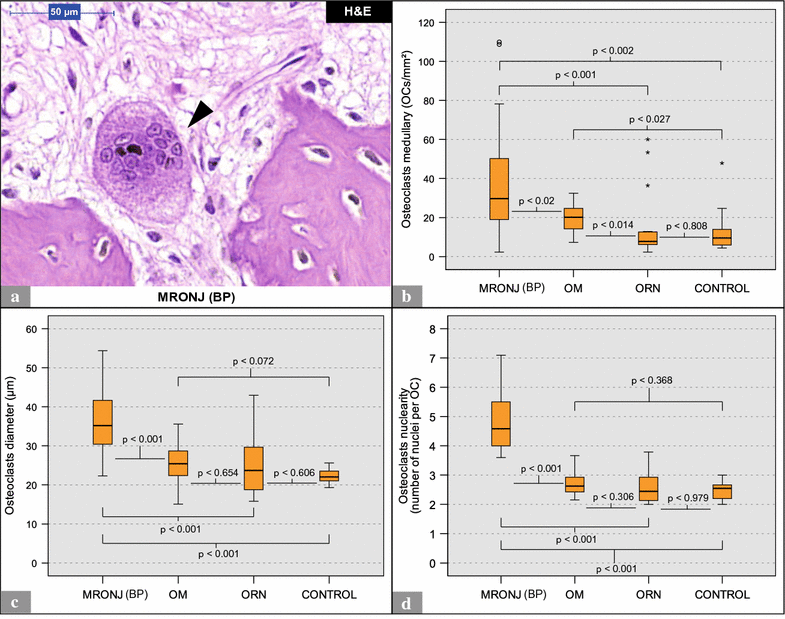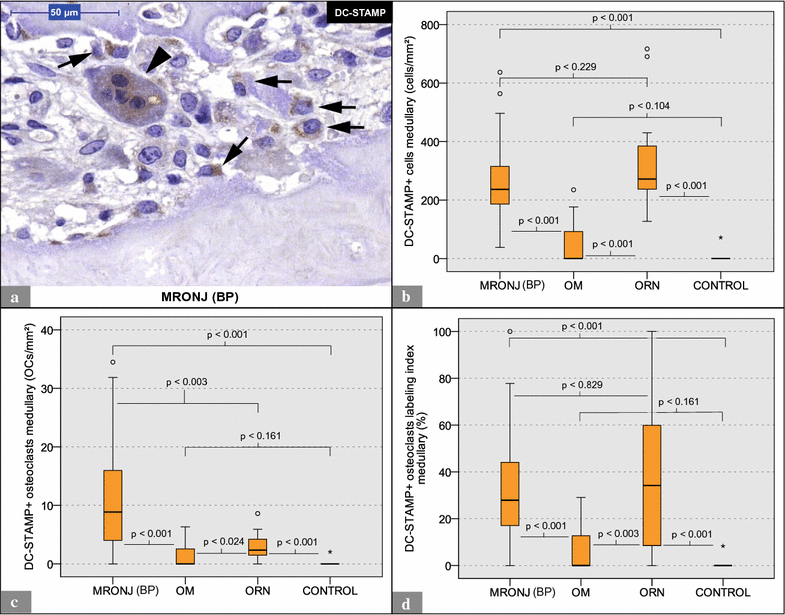Osteoclast profile of medication-related osteonecrosis of the jaw secondary to bisphosphonate therapy: a comparison with osteoradionecrosis and osteomyelitis
- PMID: 28587628
- PMCID: PMC5461625
- DOI: 10.1186/s12967-017-1230-8
Osteoclast profile of medication-related osteonecrosis of the jaw secondary to bisphosphonate therapy: a comparison with osteoradionecrosis and osteomyelitis
Abstract
Background: The medication-related osteonecrosis of the jaw secondary to bisphosphonate therapy [MRONJ (BP)] is characterized by non-healing exposed bone in the maxillofacial region. The pathogenesis of MRONJ (BP) is not fully understood. Giant, hypernucleated, inactive osteoclasts were found in MRONJ (BP) tissues, which indicated that accelerated cell-cell fusion might play a role. Dendritic cell-specific transmembrane protein (DC-STAMP) is associated with the cell-cell fusion of osteoclasts and precursor cells. Tartrate-resistant acid phosphatase (TRAP) is essential for osteoclastic bone resorption. The cell-cell fusion, as part of the osteoclastogenesis, and the resorptive activity can determine the morphology of osteoclasts. This study analyzed jaw bone from patients with MRONJ (BP), osteomyelitis (OM) and osteoradionecrosis (ORN) because a comparison with the osteoclast profiles of OM and ORN is essential for characterizing the osteoclast profile of MRONJ (BP).
Methods: Formalin-fixed routine jaw bone specimens from 70 patients [MRONJ (BP) n = 30; OM: n = 15, ORN: n = 15, control: n = 10] were analyzed retrospectively for osteoclast quantity, morphology and the expression of TRAP and DC-STAMP. The specimens were processed for hematoxylin and eosin staining (H&E), histochemistry (TRAP) and immunohistochemistry (anti-DC-STAMP) and were analyzed via virtual microscopy.
Results: The quantity, diameter and nuclearity of osteoclasts were significantly higher in MRONJ (BP) specimens than in OM, ORN and control specimens. Giant, hypernucleated osteoclasts were detected in MRONJ (BP) specimens only. Osteoclastic TRAP expression was lower in MRONJ (BP) and ORN specimens than in OM and control specimens. The DC-STAMP expression of osteoclasts and mononuclear cells was significantly higher in MRONJ (BP) and ORN specimens than in OM and control specimens.
Conclusions: This study indicates that the osteoclast profile of MRONJ (BP) is characterized by osteoclast inactivation and a high cell-cell fusion rate; however, the presence of giant, hypernucleated osteoclasts cannot be attributed to increased DC-STAMP-triggered cell-cell fusion alone. The incidental characterization of the osteoclast profiles of OM and ORN revealed differences that might facilitate the histopathological differentiation of these diseases from MRONJ (BP), which is essential because their therapies are somewhat different.
Keywords: BRONJ; Bisphosphonate; DC-STAMP; MRONJ; Osteoclasts; Osteomyelitis; Osteonecrosis; Osteoradionecrosis; TRAP.
Figures





References
-
- Tomihara K, et al. Osteomyelitis of the jaw in breast cancer patients receiving bisphosphonate therapy. Gan To Kagaku Ryoho. 2008;35(1):113–116. - PubMed
Publication types
MeSH terms
Substances
LinkOut - more resources
Full Text Sources
Other Literature Sources

